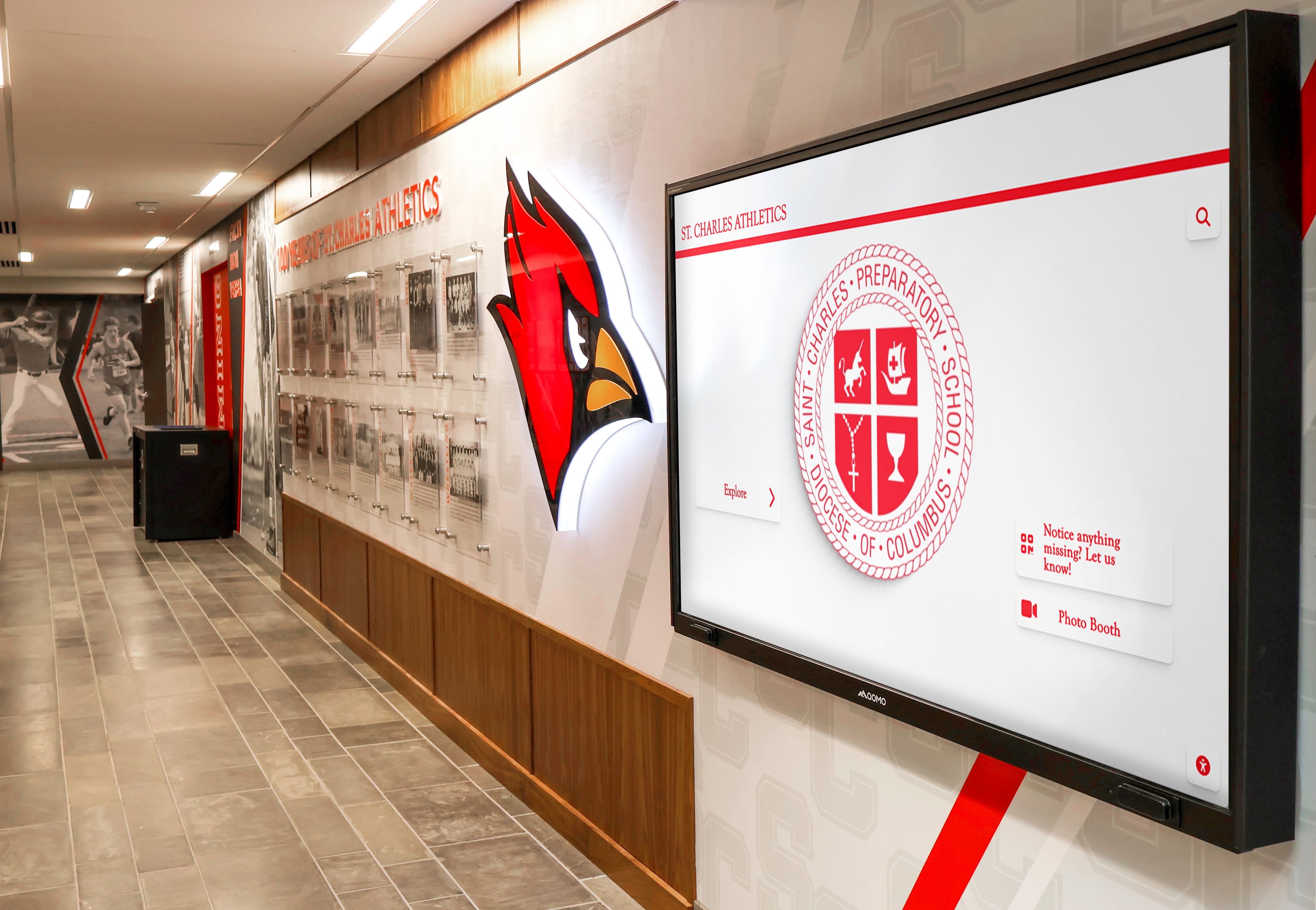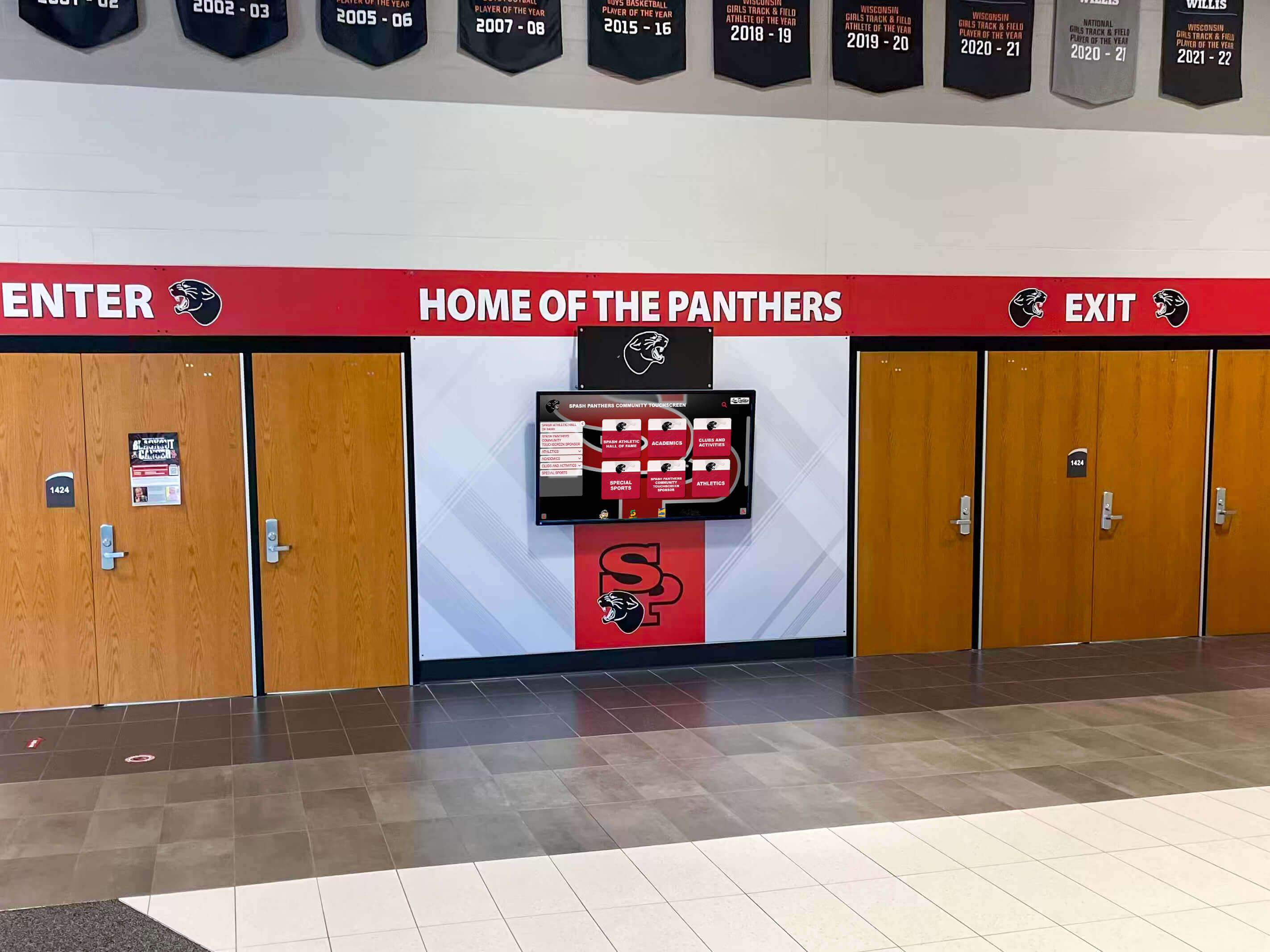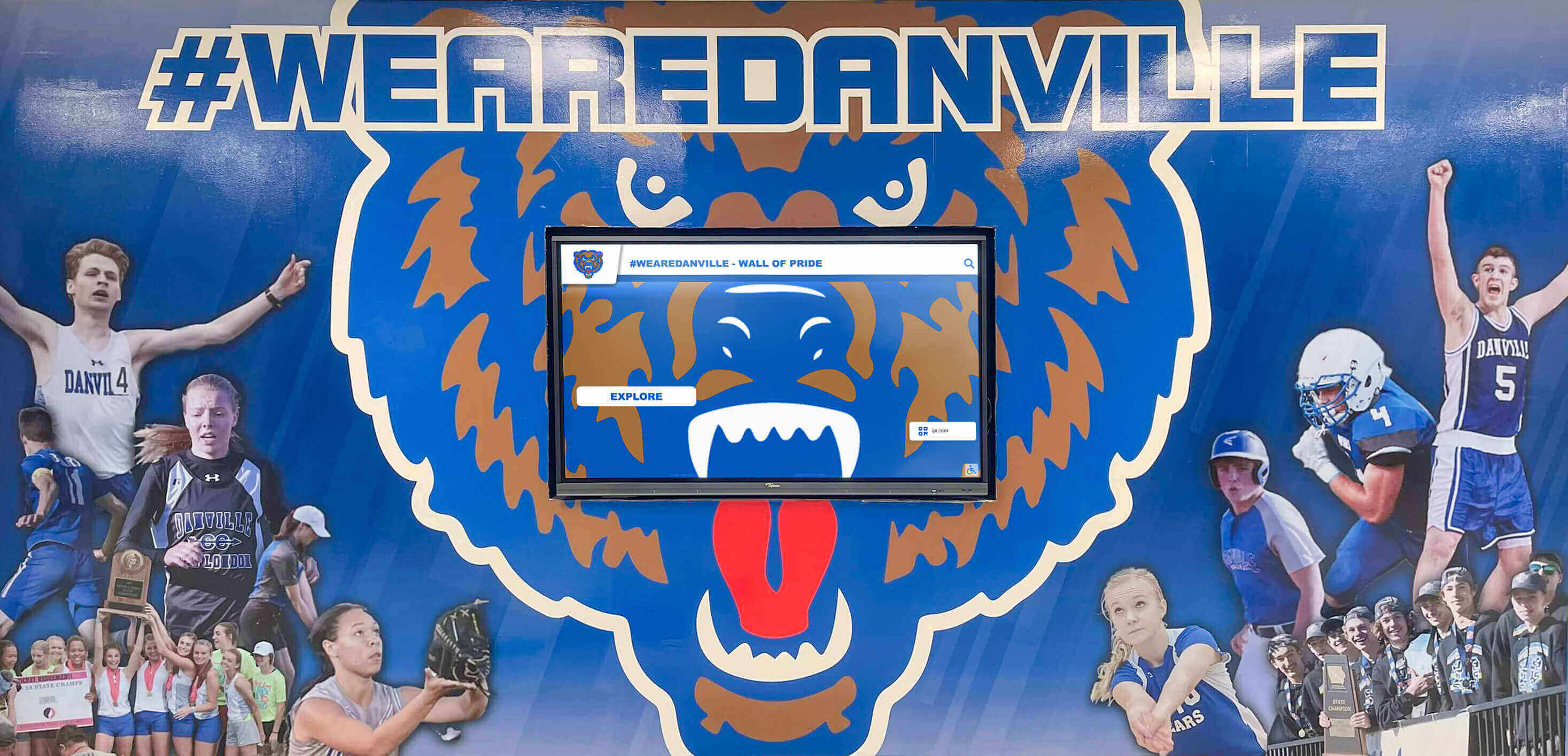Student of the Month programs have been school staples for decades, yet many institutions struggle to implement them in ways that feel meaningful, fair, and genuinely motivational. Too often, these programs become predictable routines where the same high-achieving students receive recognition month after month, selection criteria remain unclear, ceremonies feel perfunctory rather than celebratory, and displays consist of faded certificates on forgotten bulletin boards.
In 2025, successful Student of the Month programs require fresh approaches that leverage modern technology, honor diverse forms of excellence, maintain authentic fairness, and create recognition experiences that resonate with contemporary students and families. This comprehensive implementation guide provides everything schools need to launch or revitalize Student of the Month programs that genuinely make a difference.
Whether you’re establishing a program from scratch or improving an existing initiative that has grown stale, this guide examines selection strategies, recognition categories, celebration approaches, digital display solutions, family engagement methods, and assessment frameworks that transform Student of the Month from routine obligation into powerful culture-building tool.
Why Student of the Month Programs Matter
Before diving into implementation details, understanding why these programs matter helps ensure your approach addresses the fundamental purposes recognition should serve.
The Educational Impact of Student Recognition
Research in educational psychology consistently demonstrates that recognition significantly influences student motivation, behavior, and academic identity development. When implemented effectively, Student of the Month programs create multiple benefits.
Motivation and Goal-Setting: Public recognition of peer achievements creates aspirational targets for other students. When classmates see peers being celebrated for specific accomplishments, they develop clearer understanding of what excellence looks like and concrete goals they can pursue. Recognition transforms abstract expectations into visible, achievable examples.
Behavior Reinforcement: Student of the Month programs provide systematic reinforcement for behaviors and achievements schools value most. When students receive recognition for character, service, academic improvement, or other qualities, they understand these achievements matter to their school community. Consistent recognition patterns communicate institutional values more powerfully than mission statements or classroom posters ever could.

Identity Development: Recognition contributes to how students develop academic and personal identities. Students who receive acknowledgment for scholarly achievement may internalize identities as learners and scholars. Those recognized for character or service may develop identities as community contributors. Recognition helps students understand their strengths and potential pathways for personal development.
School Connection and Belonging: Being recognized communicates that schools notice students and value their contributions. This sense of being seen and appreciated strengthens emotional connections between students and institutions. Research consistently links school belonging to improved outcomes across academic performance, attendance, behavior, and social-emotional wellbeing.
Building Positive School Culture Through Recognition
Student of the Month programs contribute to broader school culture when implemented as consistent, visible components of how schools celebrate excellence.
Creating Shared Success Stories: Each recognized student becomes part of the school’s ongoing narrative about achievement and character. Over time, these recognition stories create collective history celebrating what the school community values and accomplishes together.
Strengthening Home-School Partnerships: Recognition programs provide positive touchpoints for family engagement. When families receive communication about their student’s recognition, attend ceremonies, or view displays, they engage with schools around celebration rather than only connecting during problem-focused conferences. These positive interactions strengthen school-family relationships.
Demonstrating That Achievement Matters: Actions speak louder than words. Schools that invest time, resources, and visibility in recognition programs demonstrate tangibly that achievement, character, and positive behavior genuinely matter. This demonstrated commitment proves more credible than rhetoric alone.
Designing Your Student of the Month Program Framework
Successful programs require thoughtful design decisions before implementation begins. These foundational choices shape whether your program achieves its intended purposes.
Determining Program Scope and Structure
Your first design decisions involve basic program scope and organizational structure.
Single vs. Multiple Recognition Categories:
Single Student of the Month Approach: Some schools select one student monthly who exemplifies overall excellence across multiple dimensions. This approach emphasizes selectivity and prestige, making recognition particularly special for recipients. However, it creates limited recognition opportunities and may favor traditionally high-achieving students.
Multiple Category Approach: Alternatively, schools might recognize multiple students monthly across different categories: Academic Excellence, Character, Service, Arts, Athletics, Improvement, or Leadership. Multiple categories create more recognition opportunities, validate diverse talents, and allow more students to experience being celebrated.
Most schools find that multiple categories work better for creating inclusive recognition that celebrates various forms of excellence. Consider starting with 3-5 categories and expanding based on experience and community feedback.
Grade-Level Considerations:
School-Wide Recognition: Selecting Students of the Month representing the entire school emphasizes institutional unity and creates prestigious recognition. However, younger students or those in smaller programs may rarely receive acknowledgment when competing against entire student bodies.
Grade-Level Recognition: Many schools select Students of the Month within each grade level, ensuring representation across all grades while accounting for developmental differences. Grade-level recognition creates more total recognition opportunities while allowing age-appropriate comparisons.
Department or Program-Specific Recognition: Some schools implement recognition within specific departments (English, Math, Science), programs (Career-Technical Education, Fine Arts), or other subdivisions. This approach validates excellence within specific contexts while creating numerous recognition opportunities.
Consider hybrid approaches combining elements. For example, select one Student of the Month per grade level while also recognizing one overall Character Student of the Month school-wide.

Establishing Clear Selection Criteria
Selection criteria determine whether your program feels fair, meaningful, and motivational or becomes perceived as arbitrary, exclusive, or disconnected from genuine achievement.
Academic Achievement Criteria:
For academic recognition categories, establish specific, transparent standards:
- Minimum GPA requirements (e.g., 3.5 or higher)
- Grade improvement benchmarks (e.g., raising GPA by 0.5 points)
- Subject-specific excellence (top performance in particular courses)
- Assignment completion rates and academic responsibility
- Participation quality and intellectual engagement
Make criteria specific enough that students understand exactly what qualifies them while maintaining appropriate selectivity that makes recognition meaningful.
Character and Behavior Criteria:
Character-based recognition requires careful criteria definition since qualities like integrity, kindness, or leadership resist simple quantification:
Observable Behaviors: Define character qualities through specific behavioral examples. Instead of vague “demonstrates respect,” specify “speaks courteously to peers and adults, helps classmates who are struggling, includes students who appear left out.”
Documentation Requirements: Require nominators to provide concrete examples and specific situations demonstrating character qualities rather than accepting general statements.
Multiple Confirmation: Consider requiring confirmation from multiple staff members who observe the student demonstrating character qualities in different contexts.
Improvement and Growth Criteria:
Recognition for improvement acknowledges students making significant progress even if absolute achievement levels remain moderate:
- Grade improvement over previous marking periods
- Attendance improvement for students with previous attendance challenges
- Behavior improvement for students working to overcome behavioral difficulties
- Skill development in specific subjects or competencies
- Increased participation or engagement compared to earlier patterns
Improvement recognition proves particularly meaningful for students rebuilding from setbacks or overcoming significant challenges to their success.
Creating Fair and Inclusive Selection Processes
How you structure nomination and selection processes significantly impacts program fairness and credibility.
Nomination Methods:
Teacher Nominations: Teacher nominations remain the most common approach since teachers observe students daily and can assess both achievement and character. Provide simple nomination forms requesting specific achievement descriptions rather than general endorsements.
Peer Nominations: Allow students to nominate classmates demonstrating exemplary qualities. Peer nominations help identify students who may fly under adult radar while teaching students to notice and appreciate peers’ positive qualities.
Self-Nominations: Invite students to nominate themselves by describing achievements they believe warrant recognition. Self-nomination teaches students to advocate for themselves while ensuring students without strong adult advocates can still receive consideration.
Family Nominations: Accepting nominations from families creates additional recognition pathways while engaging families in school recognition culture.
Multi-Source Nomination Benefits: Using multiple nomination sources ensures recognition opportunities don’t depend solely on visibility to particular teachers or adult relationships.

Selection Committee Structure:
Rather than single-person decisions, form diverse selection committees providing multiple perspectives:
- Cross-Department Representation: Include teachers from different subjects and grade levels preventing any single department from dominating recognition
- Administrator Participation: Include an administrator lending authority and institutional perspective
- Support Staff Input: Consider including counselors, support staff, or specialists who interact with students in different contexts
- Student Representatives: Some schools include student government representatives on selection committees for appropriate categories
Rotation and Repeat Recognition Policies:
Establish clear policies about recognition repetition:
- Can students receive Student of the Month recognition multiple times?
- Should policies prevent consecutive month recognition?
- Can students be recognized in multiple categories simultaneously or in the same month?
- How do you balance honoring consistent excellence versus distributing recognition more widely?
Document your approach and rationale clearly so the school community understands the philosophy guiding decisions.
Implementing Effective Recognition and Celebration
How you communicate and celebrate recognition determines whether Student of the Month programs create genuine motivational impact or feel like perfunctory obligations.
Moving Beyond Basic Certificates
Traditional Student of the Month recognition often consisted primarily of paper certificates and brief announcement mentions. While these elements have value, modern recognition should incorporate multiple touchpoints creating deeper impact.
Digital Recognition Displays:
Interactive touchscreen displays provide engaging, permanent recognition platforms that resonate with contemporary students. Digital displays enable several capabilities impossible with traditional approaches:
- Rich Multimedia Profiles: Include professional photographs, video messages from or about students, audio testimonials, detailed achievement descriptions, and recognition histories
- Interactive Exploration: Visitors can browse Student of the Month honorees by name, date, category, or other filters
- Easy Updates: Content management systems allow monthly updates without physical materials or installation labor
- Unlimited Capacity: Digital platforms document comprehensive recognition history without space constraints
Solutions like digital recognition displays provide purpose-built platforms designed specifically for educational recognition, making implementation straightforward even for schools without extensive technical expertise.

Creating Compelling Recognition Profiles:
Whether using digital displays or traditional formats, compelling recognition content requires specific, authentic descriptions of student accomplishments:
Example - Generic Recognition: “Sarah Jones - October Student of the Month for Academic Excellence”
Example - Compelling Recognition: “Sarah Jones earned October’s Academic Excellence Student of the Month recognition by achieving straight A’s while taking advanced coursework in mathematics and science. Her teachers note that Sarah consistently contributes thoughtful questions during class discussions, helps classmates understand difficult concepts, and demonstrates genuine intellectual curiosity. Outside class, Sarah tutors younger students in math and leads the Science Club’s community outreach initiatives.”
The second example tells a story helping others understand exactly what Sarah accomplished and why it deserved recognition. Specific descriptions make recognition feel more authentic while helping other students understand pathways to similar achievement.
Student Voice in Recognition:
When appropriate, include recognized students’ own reflections:
- What goals are they pursuing?
- What challenges did they overcome?
- Who helped them succeed?
- What advice would they offer peers?
- What does this recognition mean to them?
Student voice transforms recognition from something done to students into conversations where students actively participate in their own celebration.
Recognition Ceremonies and Presentations
Ceremonial presentation creates memorable recognition experiences elevating acknowledgment beyond simple announcements.
Monthly Recognition Ceremonies:
Schools implement recognition ceremonies at various scales:
Formal Monthly Assemblies: Dedicated monthly ceremonies specifically for Student of the Month recognition create prestigious events where families attend, administrators present recognition, and honorees receive sustained celebration. Formal ceremonies require significant time and planning but create maximum impact and visibility.
Integration into Existing Events: Alternatively, integrate Student of the Month recognition into existing assemblies, award programs, parent-teacher conference nights, or board meetings. This approach requires less dedicated time while still providing meaningful public recognition.
Classroom Presentations: For elementary schools or smaller programs, consider classroom-level presentations where principals or coordinators visit classrooms to present recognition in front of peers. Classroom presentations feel personal and special while requiring less logistical complexity than large ceremonies.
Principal’s Office Recognition: Some schools invite recognized students to the principal’s office for personal congratulations, photos, and certificate presentation. While more intimate than public ceremonies, personal principal recognition feels special and creates memorable moments for honored students.
Virtual Recognition Options: For schools with distributed students or families unable to attend in person, consider livestreaming recognition ceremonies or creating virtual recognition presentations families can view online.

Recognition Ceremony Best Practices:
Regardless of format, effective recognition ceremonies share common elements:
- Specific Achievement Descriptions: Describe exactly what each student accomplished rather than simply reading names
- Personal Touches: Include personal anecdotes, teacher testimonials, or student reflections making recognition feel authentic
- Photo Opportunities: Create opportunities for honorees to have photographs taken with certificates, with families, or in front of recognition displays
- Celebratory Tone: Maintain genuinely celebratory atmosphere communicating that schools truly value recognized achievements
- Reasonable Length: Keep ceremonies concise enough to maintain energy and attention while providing meaningful recognition for each honoree
Family Engagement and Communication
Recognition impact amplifies when families participate in celebration.
Direct Family Communication:
Contact families immediately when students receive recognition:
- Personal Phone Calls: Principals, teachers, or coordinators calling families personally creates memorable moments while demonstrating recognition importance
- Formal Letters: Written letters home describing specific achievements and recognition details provide families with lasting documentation they can share with extended family
- Email Notifications: Emails with links to digital recognition content, photos, or ceremony information ensure families stay informed
- Text Messages: Text notifications through school communication systems provide immediate alerts families can receive anywhere
Direct communication ensures families learn about recognition promptly rather than students forgetting to mention it or families discovering it weeks later.
Family Participation in Recognition:
Create opportunities for families to participate:
- Invitation to Ceremonies: Welcome families to attend recognition ceremonies or presentations
- Display Viewing Opportunities: Encourage families to visit physical or digital recognition displays
- Photo Opportunities: Facilitate family photos with recognized students at displays or ceremonies
- Reception Components: Consider simple receptions with refreshments allowing families to celebrate together
- Virtual Participation: For families unable to attend in person, provide livestreaming or recorded ceremony access
Shareable Recognition Content:
Help families extend celebration beyond school:
- Digital Certificates: Provide digital certificates or graphics families can share on social media
- Photo Files: Share professional photographs families can print or post online
- Recognition Videos: Create short video clips featuring honorees that families can share with distant relatives
- Social Media Features: With appropriate permissions, feature recognized students on school social media where families can engage through likes, comments, and shares
Leveraging Technology for Modern Recognition
Digital technology transforms how schools implement Student of the Month programs while solving common challenges that plagued traditional approaches.
Digital Display Platforms and Content Management
Modern recognition software provides comprehensive platforms managing entire programs from nomination through public celebration.
Key Platform Capabilities:
Streamlined Nomination Collection: Digital forms allow nominators to submit nominations easily while providing structured fields ensuring consistent, complete information. Online nomination collection eliminates paper-based tracking while creating organized records.
Content Management Systems: Intuitive content management interfaces allow school staff to create rich recognition profiles without technical expertise. Cloud-based systems enable content updates from anywhere rather than requiring physical access to display locations.
Automated Communication: Recognition platforms can trigger automatic notifications to students, families, staff, and selection committees at appropriate milestones, reducing manual communication workload.
Recognition Analytics: Digital systems track recognition patterns enabling equity analysis: Which students, grades, demographics, or categories receive recognition? Are there gaps requiring attention? Data-informed improvement ensures recognition remains fair and inclusive over time.
Historical Archives: Digital platforms automatically create searchable historical archives documenting all Student of the Month recipients. Archives preserve institutional history while allowing alumni to find their own recognition years or decades later.
Professional touchscreen software designed for recognition applications streamlines implementation while providing engaging user experiences that capture attention.

Benefits Over Manual Approaches:
Traditional paper-based Student of the Month programs require significant manual effort:
- Collecting and organizing paper nominations
- Coordinating selection committee reviews of physical documents
- Creating certificates, displays, and announcements from scratch monthly
- Manually communicating with families and recognized students
- Documenting recognition in filing systems
- Physically updating bulletin boards or displays
Digital platforms automate many processes, reducing administrative burden while improving consistency, quality, and historical documentation.
Social Media Integration and Online Recognition
Strategic social media use amplifies recognition beyond campus while creating shareable content that engages broader communities.
Social Media Recognition Strategies:
Individual Recognition Posts: Create dedicated posts celebrating each Student of the Month with photos, achievement descriptions, and appropriate personal information. Individual posts give each honoree dedicated visibility and shareable content for their families.
Video Recognition Content: Short video interviews with recognized students, video compilations featuring photos and achievements, or video messages from teachers create engaging content that performs well on social platforms while honoring students meaningfully.
Stories and Reels: Platform-specific formats like Instagram Stories or Facebook Stories provide additional recognition touchpoints reaching audiences in different ways than traditional posts.
Community Engagement: Recognition posts create opportunities for community members to interact through congratulatory comments, shares, or reactions. This public appreciation extends recognition impact while demonstrating community support for student achievement.
Alumni Connections: Social media recognition often reaches alumni who engage by congratulating current students or sharing memories of their own school experiences. These intergenerational connections reinforce school community bonds.
Privacy and Permission Considerations:
Always obtain appropriate permissions before featuring students on public social media. Follow district policies regarding student privacy, photo releases, and personally identifiable information. When in doubt, use first names only or request explicit family permission for fuller identification.
Online Halls of Fame and Website Integration
Complement physical or interactive displays with web-accessible recognition content:
Website Recognition Sections: Dedicate website pages to Student of the Month recognition featuring current month honorees, searchable archives of previous recognition, explanation of program criteria and nomination processes, and photo galleries celebrating recipients.
Virtual Hall of Fame Access: For schools implementing touchscreen recognition displays, many platforms offer companion web applications providing online access to the same recognition content. Virtual access extends recognition beyond those who can physically visit campus, allowing alumni, distant family members, and prospective families to explore achievement history.
Integration with School Communications: Link to Student of the Month content from newsletters, announcement pages, and other school communication channels ensuring recognition maintains ongoing visibility rather than being viewed once and forgotten.
Special Considerations for Different School Levels
Student of the Month programs should adapt to developmental needs and contexts of different age groups.
Elementary School Recognition Programs
Developmental Appropriateness:
Elementary students respond well to frequent, immediate, concrete recognition. Monthly recognition provides appropriate frequency for this age group while creating regular opportunities for celebration.
Elementary Program Considerations:
- Simple, Clear Criteria: Young children need criteria they can understand easily
- Behavior and Character Emphasis: Elementary recognition often emphasizes behavior, character, and effort alongside academics
- Classroom-Level Recognition: Consider each classroom selecting Students of the Month rather than school-wide competition, creating more recognition opportunities
- Celebratory Presentation: Make presentations feel special and exciting for young children
- Parent Engagement: Elementary families typically maintain close school connections, making family participation particularly feasible
Multiple Intelligence Recognition:
Elementary programs should recognize diverse strengths: academic achievement, kindness and character, artistic creativity, athletic participation, leadership and responsibility, improvement and growth, and helping others.

Middle School Recognition Programs
Navigating Adolescent Development:
Middle school students experience unique developmental characteristics affecting how they respond to recognition:
- Some students feel uncomfortable with public recognition and attention
- Peer perceptions hold particular importance during early adolescence
- Students become more aware of social comparison and competition
- Recognition preferences vary widely within age groups
- Identity formation accelerates during middle school years
Middle School Program Adaptations:
Student Choice: Allow students to choose how publicly they want recognition presented Group Recognition Options: For students uncomfortable with individual spotlight, consider team or group recognition Emphasis on Character: Middle school represents crucial character development years; emphasize character recognition alongside academics Peer Nomination: Middle schoolers respond well to peer nomination processes Social Media Consideration: Be particularly sensitive to social media recognition given middle school social dynamics
For more guidance on middle school recognition, explore resources about middle school recognition approaches and age-appropriate strategies.
High School Recognition Programs
College and Career Connections:
High school recognition should connect to students’ post-secondary aspirations:
Documentation for Applications: Recognition that students can include in college applications, scholarship applications, or resumes adds practical value beyond symbolic recognition.
Achievement Narratives: Help students develop recognition into achievement narratives they can articulate in essays, interviews, or personal statements.
Leadership Development: High school recognition can emphasize leadership qualities valuable for college, careers, and community involvement.
Diverse Pathways Recognition: Recognize achievements relevant to various post-graduation pathways: traditional college, technical programs, military service, entrepreneurship, or direct employment.
High School Program Features:
Student Leadership in Selection: Involve high school students more extensively in nomination, selection, and presentation processes
Comprehensive Profiles: High school recognition can include more sophisticated content including detailed achievement descriptions, student reflections on growth, future goals and college/career plans, and comprehensive recognition histories across high school years
Integration with Other Recognition: Connect Student of the Month recognition with other high school honors like National Honor Society, subject-specific awards, or athletic recognition
Addressing Common Program Challenges
Even well-designed programs face predictable challenges. Anticipating problems helps schools implement solutions proactively.
Preventing Recognition Repetition Issues
Challenge: Same Students Repeatedly Recognized
The most frequent complaint about Student of the Month programs involves the same students receiving recognition month after month while others never experience being celebrated.
Solutions:
Multiple Recognition Categories: Creating diverse categories (academic, character, service, arts, athletics, improvement, leadership) expands opportunities for students with different strengths. When recognition validates various forms of excellence, more students have realistic pathways to being honored.
Rotation Policies: Implement policies limiting how frequently students can receive recognition:
- No consecutive month recognition in the same category
- Maximum recognition frequency (e.g., twice annually)
- Eligibility exclusion for specified periods after recognition
Document rotation policies clearly so everyone understands the approach and rationale.
Grade-Level Recognition: Within-grade recognition prevents older or more advanced students from dominating school-wide recognition, ensuring every grade level has students experiencing celebration.
Improvement-Based Categories: Recognition categories emphasizing growth and improvement rather than absolute achievement create opportunities for students at different starting points and achievement levels.
Distribution Monitoring: Track recognition patterns across demographics, grades, programs, and categories. When data reveals gaps, selection committees can deliberately ensure broader distribution.

Maintaining Meaningful Standards
Challenge: Balancing Accessibility with Selectivity
Recognition should feel achievable enough that students are motivated to pursue it, yet selective enough that being recognized feels meaningful and earned.
Solutions:
Clear Written Criteria: Transparent, specific criteria help students understand exactly what qualifies for recognition. When standards are clear, recognition feels merit-based rather than arbitrary.
Consistent Application: Apply criteria consistently across all nominations and selections. Inconsistent application undermines credibility and fairness perceptions.
Tiered Recognition: Consider multiple recognition tiers: highest honor (Student of the Month), honorable mention, or certificate of commendation. Tiered approaches provide acknowledgment at different levels while maintaining prestige for top recognition.
Avoiding Grade Inflation: Resist pressure to recognize more students simply to spread recognition wider if additional students don’t meet established criteria. Recognition loses meaning when standards erode to include everyone.
Regular Criteria Review: Periodically assess whether criteria remain appropriately calibrated—not so difficult that almost no one qualifies, yet not so easy that recognition becomes routine.
Ensuring Fair Representation
Challenge: Certain Groups Consistently Excluded
When recognition patterns consistently exclude students based on demographics, programs, abilities, or other characteristics, excluded students develop resentment rather than inspiration.
Solutions:
Diverse Selection Committees: Committee diversity helps ensure multiple perspectives and prevents unconscious bias from dominating decisions.
Multiple Nomination Sources: Accepting nominations from teachers, students, families, and other sources ensures students don’t need specific adult advocates to receive consideration.
Representation Monitoring: Track recognition across demographics and programs. When patterns reveal consistent underrepresentation, investigate causes and implement targeted solutions.
Barrier Identification: Examine whether program structures create unintentional barriers. Do selection criteria inadvertently favor students with certain advantages? Are nomination processes accessible to all families regardless of language or technology access? Do recognition categories reflect diverse forms of excellence?
Inclusive Categories: Ensure recognition categories celebrate achievements accessible to students in various programs, with different abilities, and from diverse backgrounds.
Measuring Program Success and Continuous Improvement
Effective Student of the Month programs require ongoing assessment and refinement based on evidence and stakeholder feedback.
Defining Success Metrics
Establish specific metrics for evaluating whether your program achieves intended purposes:
Participation and Engagement Metrics:
- Number of nominations received monthly
- Diversity of nomination sources (teachers, students, families)
- Percentage of student body receiving recognition annually
- Distribution of recognition across grades, demographics, categories
- Family attendance at recognition ceremonies
- Engagement with recognition displays or online content
- Social media reach and engagement with recognition posts
Student and Stakeholder Satisfaction:
- Student surveys about recognition fairness and meaningfulness
- Family satisfaction with recognition communication and celebration
- Teacher feedback about program workload and impact
- Selection committee assessment of process effectiveness
Behavioral and Academic Indicators:
While attribution proves difficult, monitor trends potentially connected to recognition:
- Student attendance patterns
- Behavioral referral trends
- Academic performance indicators
- Participation in activities and programs
- School climate survey results about belonging and pride
Program Sustainability Indicators:
- Consistency of monthly recognition implementation
- Quality and timeliness of recognition content
- Staff capacity for maintaining program
- Budget sustainability for program costs
Continuous Improvement Process
Student of the Month programs should evolve based on experience and evidence rather than remaining static after initial launch.
Annual Program Review:
Conduct comprehensive assessment annually:
- Analyze recognition distribution data identifying patterns or gaps
- Review engagement metrics understanding what resonates with stakeholders
- Collect systematic feedback from students, families, staff
- Assess alignment between stated goals and actual outcomes
- Identify specific improvement opportunities
Iterative Refinement:
Make evidence-based improvements:
- Adjust criteria based on experience with appropriateness and effectiveness
- Add or modify recognition categories addressing identified gaps
- Refine selection processes improving fairness or efficiency
- Enhance presentation formats increasing engagement
- Improve communication reaching families and community more effectively
- Update technology or displays maintaining currency and appeal
Documentation and Knowledge Transfer:
Document program procedures, refinements, and lessons learned:
- Create program handbook capturing selection criteria, procedures, responsibilities
- Document best practices for nomination, selection, presentation, communication
- Preserve historical knowledge that helps new staff understand program evolution
- Share lessons learned preventing others from repeating problems you’ve solved
Recognition programs should continuously evolve in response to changing needs, feedback, and evidence about what works in your specific context.
Implementation Planning and Launch Timeline
Schools ready to launch or revitalize Student of the Month programs should follow systematic planning ensuring successful implementation.
Planning Phase (2-3 Months Before Launch)
Month 1: Program Design
- Form planning committee including diverse stakeholder representation
- Review this guide and research best practices from other schools
- Define program goals and intended outcomes
- Determine program scope: categories, grade levels, frequency
- Establish selection criteria for each recognition category
- Design selection processes and committee structures
- Identify necessary resources: budget, personnel time, technology
Month 2: Infrastructure Development
- Select recognition technology platforms if using digital solutions
- Design recognition presentation formats (certificates, displays, profiles)
- Create nomination and selection forms and processes
- Develop communication templates for students, families, staff
- Establish content creation workflows (photography, profile writing)
- Train selection committees and staff on procedures
- Begin communicating with school community about upcoming program
Month 3: Pilot and Preparation
- Conduct pilot month with small group testing processes
- Gather feedback from pilot participants
- Refine procedures based on pilot experience
- Finalize all forms, templates, and materials
- Complete any technology setup or display installation
- Create comprehensive launch communication plan
Launch and Operations (Month 4 and Beyond)
Initial Launch:
- Announce program school-wide with clear explanation of criteria and processes
- Open nomination period for first official month
- Implement selection process
- Create recognition content for honorees
- Conduct first recognition ceremony or presentation
- Communicate with families and broader community
- Publish recognition on displays, website, social media
Ongoing Monthly Operations:
Establish consistent monthly cycles:
- Week 1: Open nomination period
- Week 2-3: Selection committee review and decisions
- Week 3: Create recognition content and communicate with families
- Week 4: Recognition ceremony/presentation and public recognition
- Ongoing: Monitor program effectiveness and gather feedback
Quarterly Review:
Every 3-4 months, review program implementation:
- Assess recognition distribution patterns
- Gather stakeholder feedback
- Identify any implementation challenges
- Make incremental improvements to processes or criteria
Annual Assessment:
Conduct comprehensive annual review:
- Analyze full year of data and feedback
- Celebrate program successes and acknowledge challenges
- Make strategic improvements for following year
- Update program documentation
- Recognize and appreciate staff who coordinate program
Technology Solutions That Transform Recognition
Modern digital technology addresses common Student of the Month program challenges while enhancing recognition quality and reducing administrative burden.
Comprehensive Recognition Platforms
Purpose-built recognition platforms provide integrated solutions managing entire programs:
Digital Recognition Display Systems:
Interactive touchscreen displays installed in high-traffic school locations create engaging recognition platforms that students, families, and visitors explore:
- Professional photographs and detailed achievement descriptions
- Video testimonials and multimedia content
- Interactive browsing and search functionality
- Automatic content updates through cloud-based management
- Unlimited recognition capacity without physical space constraints
- Professional appearance that never fades or deteriorates
- Analytics tracking how community engages with recognition content
Solutions like Rocket Alumni Solutions provide comprehensive platforms designed specifically for educational recognition, offering intuitive content management that school staff can use without technical expertise.

Cost-Effective Implementation
Schools often hesitate to implement digital recognition solutions due to perceived costs. However, modern platforms frequently prove cost-effective compared to traditional approaches:
Traditional Approach Ongoing Costs:
- Monthly certificate printing and framing
- Bulletin board materials and supplies
- Photography costs or equipment
- Staff time for manual updates and display changes
- Physical storage for recognition materials
- Limited recognition capacity requiring difficult choices about who to honor
Digital Platform Cost Benefits:
- One-time hardware and software investment
- Minimal ongoing costs (typically subscription fees)
- Unlimited recognition capacity allowing comprehensive documentation
- Reduced staff time through automated processes
- No consumable materials or supplies
- Professional quality that persists indefinitely
- Historical archives providing long-term value
Many schools find that digital solutions pay for themselves within a few years through reduced materials costs and staff time savings while providing dramatically enhanced capabilities.
Integration with School Systems
Modern recognition platforms often integrate with existing school systems:
- Student Information Systems: Import student data automatically rather than manual entry
- Communication Platforms: Connect with school messaging systems for automated notifications
- Websites: Embed recognition content in school websites providing online access
- Social Media: Facilitate easy sharing of recognition content to social platforms
- School Apps: Include recognition features in mobile applications families already use
Integration reduces duplicate data entry while creating seamless experiences across school communication channels.
Conclusion: Building Recognition Culture Through Consistent Excellence
Student of the Month programs represent far more than monthly announcements and certificates. When implemented thoughtfully, these programs create consistent, visible recognition systems that validate achievement, communicate values, motivate excellence, build school pride, strengthen school-family connections, and establish cultures where accomplishment receives genuine celebration.
Effective programs share common characteristics: clear, fair selection criteria consistently applied; diverse recognition categories celebrating various forms of excellence; meaningful presentation formats that make recognition feel genuinely special; modern technology enhancing rather than replacing personal touches; family engagement amplifying recognition impact; continuous improvement based on assessment and feedback; and sustainable implementation that persists across leadership changes.
The investment schools make in Student of the Month programs pays dividends in student motivation, school culture, family engagement, and community pride. Recognition communicates that schools notice students, value their efforts, celebrate their accomplishments, and believe in their potential. During formative school years when students develop academic identities and relationships with learning, consistent recognition helps shape positive trajectories that extend far beyond recognition certificates.
Essential Implementation Principles:
- Design programs around genuine student needs rather than adult convenience
- Establish truly fair, transparent selection processes that maintain credibility
- Create recognition experiences that feel meaningful rather than perfunctory
- Honor diverse achievements rather than narrow definitions of success
- Engage families authentically in recognition celebration
- Leverage technology to enhance quality while reducing burden
- Monitor implementation ensuring equity and effectiveness
- Continuously improve based on evidence and feedback
- Maintain long-term commitment through leadership transitions
- Celebrate students in ways that inspire peers and validate accomplishments
Ready to transform how your school celebrates student achievement? Modern solutions like Rocket Alumni Solutions provide comprehensive platforms designed specifically for educational recognition, offering intuitive content management, engaging interactive displays, and proven approaches that help schools build the recognition cultures their students deserve.
Your students achieve remarkable things every month—effective Student of the Month programs ensure those achievements receive the celebration that inspires continued excellence and builds school communities where all students can thrive.




































